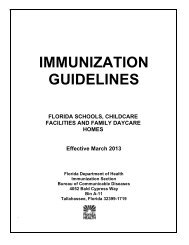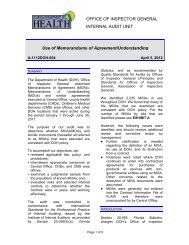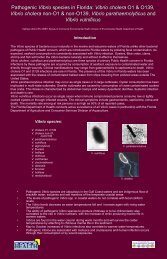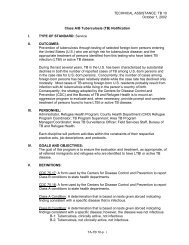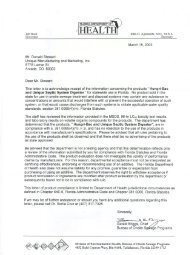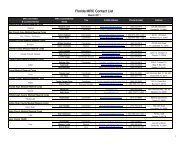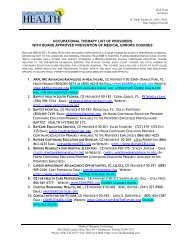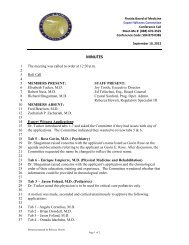White Paper - Florida Department of Health
White Paper - Florida Department of Health
White Paper - Florida Department of Health
Create successful ePaper yourself
Turn your PDF publications into a flip-book with our unique Google optimized e-Paper software.
Satellite telecommunication systems utilize human-made satellites, which are highly specialized<br />
wireless receiver/transmitters that act as radio wave relay stations and require the following<br />
earth-based equipment: the antenna (<strong>of</strong>ten a dish which will vary in size to match the particular<br />
service for which they are designed) and the associated equipment (receiver/decoder, transmitter<br />
which usually are packaged as part <strong>of</strong> the modem). The dish/antenna can fixed with coordinates<br />
set to one position (e.g. fixed to the side <strong>of</strong> a building); fixed with coordinates that need to be set<br />
for each new location and position (e.g. fixed to a mobile van – utilizing an auto-acquire feature);<br />
or portable with coordinates that need to be set for each new location and position (e.g. a<br />
briefcase style dish).<br />
The most common telecommunication satellites are in a geostationary orbit. In this orbit,<br />
satellites do not appear to move in relation to the earth. Thus, an earth-based dish/antenna only<br />
need acquire the satellite once to have continuous communication. In orbits closer to the earth<br />
(medium-earth orbit or low-earth orbit) the satellite appears to travel around the earth, thus<br />
creating the need for the earth-based dish/antenna to track the satellite or satellites.<br />
A satellite telecommunications system with satellite return works in the following basic manner:<br />
the earth-based satellite dish/antenna acquires a satellite; it uses the Indoor Transmit Unit (ITU)<br />
to send data up to the satellite; and the satellite in turn sends the data to a terrestrial-based<br />
Network Operations Center (NOC). The NOC forwards the request to the Internet, where the<br />
data is routed to its final destination. Data returning from the Internet is routed to the NOC,<br />
where it is sent up to the satellite. The satellite relays the data to the specified satellite<br />
dish/antenna where, the satellite telecommunications system's Indoor Receive Unit (IRU)<br />
receives and decodes the high-speed data, then presents the data to the user.<br />
Bandwidth, latency, security, and the ability to acquire a satellite are the main problems<br />
associated with satellite telecommunication service. Depending on service plan, bandwidth can<br />
run up to a maximum <strong>of</strong> 1.0 Mbps upload and 2.5 Mbps download. The issue with bandwidth is<br />
whether 384 Mbps (the bandwidth needed for diagnostic quality videoconferencing) can be<br />
guaranteed. Small transmission delays do occur, but these are normally in the millisecond time<br />
frame, thus, not an issue in teledentistry. While security <strong>of</strong> data transmitted via radio waves can<br />
be a problem, most systems come with encryption to overcome this issue. Trees, tall buildings,<br />
and rain can affect service by blocking the dish/antenna’s sightline to the satellite. However,<br />
newer systems, like the Broadband Global Area Network (BGAN) system, eliminate most<br />
weather related transmission issues.<br />
HughesNet is the main provider <strong>of</strong> satellite telecommunication service in North America. 54<br />
Technical Standards<br />
“DICOM” or “Digital Imaging and Communication in Medicine” 34, 35, 55, 56 – is the industry<br />
standard for communications transfers <strong>of</strong> digital images and other medical information between<br />
computers. The DICOM Standards Committee exists to create and maintain international<br />
standards for communication <strong>of</strong> biomedical diagnostic and therapeutic information in disciplines<br />
that use digital images and associated data. The goals <strong>of</strong> DICOM are to achieve compatibility<br />
and to improve workflow efficiency between imaging systems and other information systems in<br />
13








